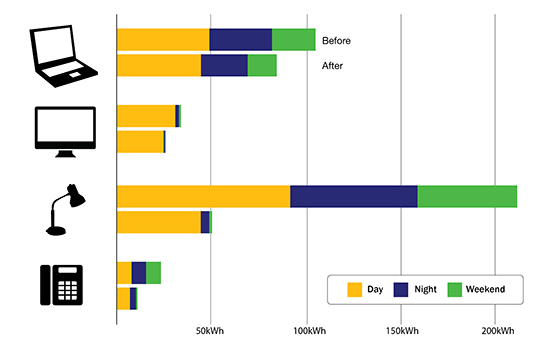Press Release: Carnegie Mellon Researchers Develop Dashboard To Help Reduce Energy Use in Office Buildings
Contact: Pam Wigley / 412-268-1047 / pwigley@andrew.cmu.edu
Michelle Bard / mbard@andrew.cmu.edu
PITTSBURGH—A team at Carnegie Mellon University's School of Architecture has developed a dashboard that helps people to see how much energy they use at work and how to reduce this use to help the environment.
Ray Yun, a doctoral student in the School of Architecture, has developed an Intelligent Dashboard to evaluate plug load energy savings in the workplace. Plug load, he explained, refers to how many things are actually plugged into outlets at your desk and, as a result, use energy.
By helping building occupants see their actual energy use, see recommendations for ways to save energy, and allowing the online ability to control plug loads at each desk, Yun and the Center for Building Performance team are proving that dashboards save energy.
"What I am most proud of is helping people to see energy saving opportunities," Yun said. "Office workers have no big incentive to put any effort into conserving energy at work, since they don't pay the bills. Without providing rewards or penalties or forcing workers to use our dashboard, we have successfully assisted them in voluntarily acting on behalf of the environment."
The field testing of the Intelligent Dashboard for Occupants (ID-O) engages 80 employees at a major Pittsburgh corporation in online communication, consultation and control supported by plug-in devices manufactured by Plugwise™ that measure the energy consumption of each device and provide digital on-off control. Office occupants were divided into four groups to evaluate the effectiveness of different interfaces being developed:
Group A served as the control group and was just monitored. Group B participants could see their ongoing energy usage on a dashboard but had no online control ability. Group C could see their energy use and had the ability to control their usage online, while Group D was given energy use monitors, online controls and the ability to use their work schedule on a calendar to control unnecessary plug loads.
After six weeks, Group D participants averaged a 35.4 percent savings in their plug load energy consumption in the workplace. Without the calendar automation, Group C averaged 20.2 percent energy savings, while Group B with information but no online control averaged 9 percent energy savings. Even the group with no dashboard saved 3.6 percent energy, likely through heightened awareness.
"Energy dashboards for plug load savings in the workplace are critical to saving electricity in a nation scrambling to produce electricity without environmental damage," said Vivian Loftness, a University Professor and former head of the School of Architecture at CMU.

A CMU study showed that during a nine-month period, using the CMU Intelligent Dashboard ID-O offered significant energy savings for corporations. Those savings were most visible when laptops, computer monitors, lights and phones were turned off at night and during weekends. The graphic (pictured above) extrapolates that information over a year.
"Buildings consume about 40 percent of all energy used in the U.S. and about 70 percent of the nation's electricity. As a nation, we have a huge obligation to clean up our act. So let's start by asking ourselves what can we do without changing our quality of life," she said. "The Intelligent Dashboard is about empowering the building's occupants to achieve positive change."
The team's work has received both national and international attention. The Wall Street Journal published an article on Sept. 22, 2013, and the Dashboard has been presented to audiences in Switzerland, Singapore, Sydney and Philadelphia. Presentations are now scheduled for Toronto and Crete.
Yun's research team members in the School of Architecture are Vivian Loftness, Azizan Aziz, Bertrand Lasternas, Chenlu Zhang, Yunjeong Mo and Jie Zhao, and Peter Scupelli in the School of Design.
This team joins more than 100 CMU faculty members working together across disciplines to solve the world's toughest energy challenges through the university's Wilton E. Scott Institute for Energy Innovation.
###